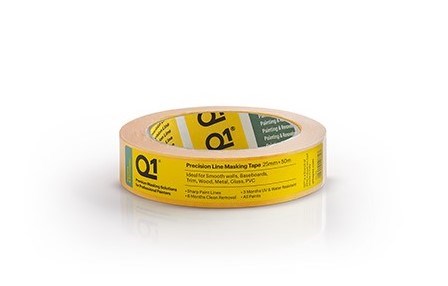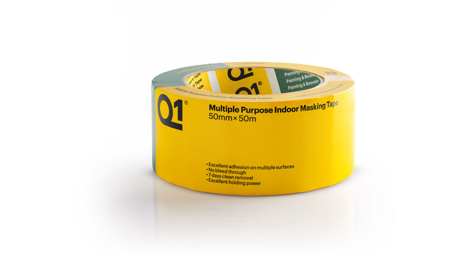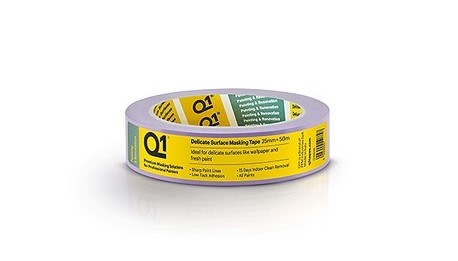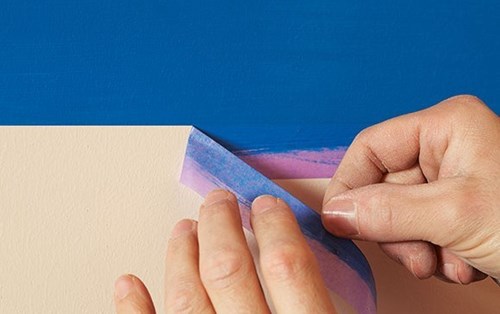Learning to paint means learning to mask. And with good masking everything is possible.
In painting and decorating field, it is required an excellent preparation. Using the right products and techniques for masking will make the overall finish much better and flawless.
In this article, we’ll show you everything you need to achieve a perfect result in less time.
Be sure to choose a range of masking tapes with easy removal, because they actually stick better than stronger tapes. We highly suggest the use of Q1® masking tapes for their application and performance quality, residue free removal and price point.
Q1® range of painters’ tapes is perfect to get any result you want.
Perfect for outdoor use and more precise work

Q1® Precision Line Masking Tape is an ultra-thin paper masking tape for clean lines and perfect razor sharp paint edges. It sticks perfectly on smooth surfaces, assures a perfect adhesion and can be easily removed without leaving residues.
Q1® Precision Line Masking Tape is a professional high-performance product, is UV and water-resistant and is engineered for HPLV and airless paint spray. It’s perfect for precise high quality spray painting jobs, indoor or outdoor.
For indoor use, with easy removal

Q1® Multi Purpose Indoor Masking Tape is a semi crepe paper masking tape with natural rubber based adhesive. It prevents paint bleed and assures a clean and easy removal within 7 days, without leaving any residue on the application surface or peeling of the substrate.
This multi surface masking tape sticks well to several and irregular surfaces, such as baseboards, trims, walls, wood, metal. This product is engineered for almost all indoor paint or renovation works.
For delicate indoor paintworks

This product is a low tack paper masking tape specifically designed for the preservation of delicate surfaces during the painting process. It can be used on wallpaper or fresh plaster and sticks well to multiple and irregular surfaces such as baseboards, trims, walls, wood or metal. Q1® Delicate Surface Masking Tape assures easy removability on smooth and slightly textured surfaces.
Easy to tear, this product is perfect when you need a lower adhesion level to help prevent surface damage and to get sharp lines, preventing paint bleed.
This masking tape guarantees 15 days indoor clean removal.
Pro tip: you can buy our masking tapes in bulk!
When masking windows, doors or similar, clean the surface with a damp cloth, then dry it. This tiny operation will actually save you more time than you think, because masking tape will cling easier and you’ll save time. In fact, paper masking tape won’t come off because of dirt between the adhesive part and the surface you need to mask. As a result, you won’t have to spend time to reattach your masking tape.
Corners: for some painters, they are a real nightmare. With this simple technique, it will be easy to get a perfect fit even on inside corners.
To prep for painting corners, start by running the first piece of tape up the wall, making it a little long. Press the tape down into the corner with a putty knife. Then cut along the crease with a sharp utility knife and remove the cut-off piece.
Just like this. Easy!
When masking off areas, masking film and paper are the perfect choice, especially if they already have tape on one side. Why should you use masking tape if your surface protection tools are pre-taped? Because it will be soooo much easier and faster to remove.
In fact, applying masking tape first makes de-masking a lot easier, pulling off everything very quickly, and it will cling to the surface even easier. You’ll thank us later.
Don’t be in a rush, even if the clock is ticking. Remove the masking tape gradually, holding the finish in a 45-degree angle from the wall or the surface. After the tape reaches the base of the painted area, pull it in a 45-degree angle down. If the tape is on peak of the painted region, pull it in a 45-degree angle upwards.

Pay attention to this: the longer you leave masking tape on a surface, the harder it is to remove. Unless you use a low tack masking tape. This kind of adhesive tape is easy to pull off and it doesn’t leave glue on the surface you are painting.
Otherwise, you’ll have to bring turpentine with you and lightly rub on any sticky tape residue.
Learn more about when to remove masking tape.
If the paint is too dry (water-based paint dries pretty fast), score masking tape before pulling it off, especially if you made multiple coats. Use a putty knife before you pull it off. This will break any bond that has formed with the paint and ensure that the masking tape will come off quickly without damaging your paint job.
These are the main techniques that will save you much more time. With the right masking products, and a bit of practice, you will be ready for painting in a few seconds.
Saving time means a more satisfied customer, and more money saved.
Let's get in touch.
Keeping excellent masking products in your shop means selling efficiency and high productivity to your customers. Join the Q1® family to watch your business grow.